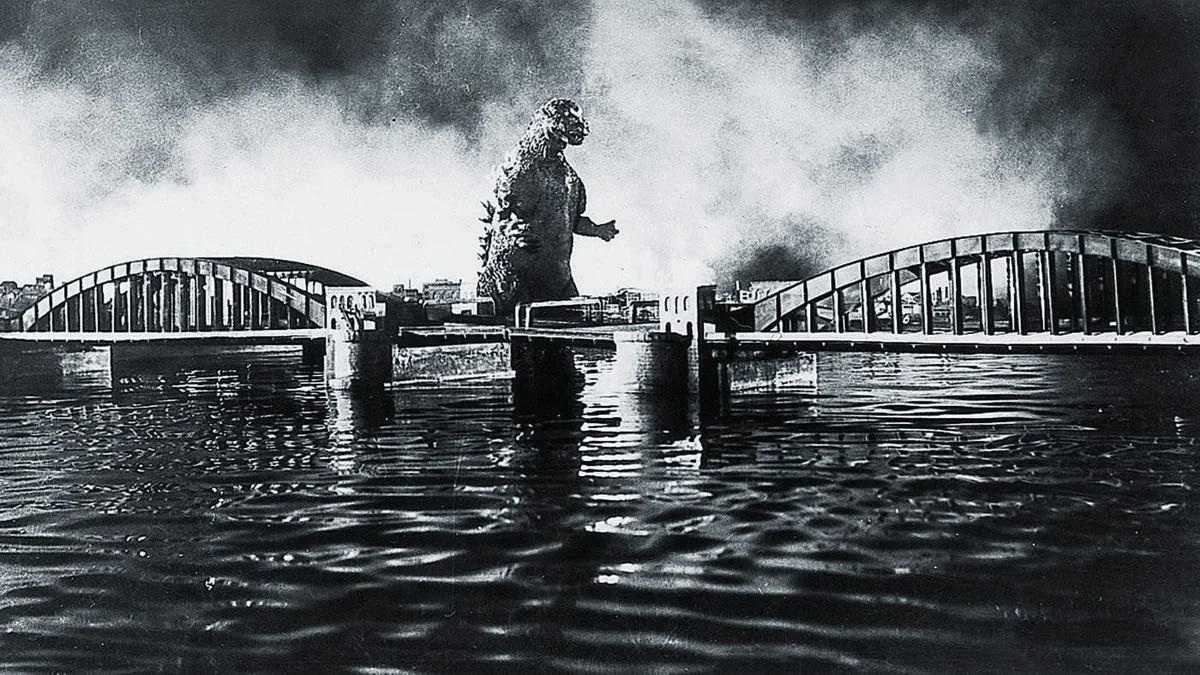Godzilla (1954) Film Review and Summary
SOLID 7/10
Godzilla is now a character within the macrocosm of iconic American film franchises. The monster is more aligned with supernatural characters such as King Kong and the Aliens from the Alien series; these creatures are symbols of the capitalist commodification of cinema. It is ironic that films like Godzilla vs. Kong (2021) presents the prehistoric supernatural figure as an irreverent feature of pop-culture because, unbeknownst to most, Godzilla is the personification of the nuclear warfare that permeated the mid-20th century.
Gojira (Godzilla) (1954) opens with a shot that displays Japanese naval soldiers. A brief showcase of the nationalism that was so important in rebuilding the Japanese culture that was decimated by the 1945 bombings of Hiroshima and Nagasaki, the latter of which is directly referenced in the film with a sense of despair. The titular monster is introduced in a manner that is described as a “volcanic eruption”, as the film’s technical proficiency in scaling makes Godzilla seem immense in size. Godzilla bursts out of the water in a fury of light on way to executing utter destruction upon the unsuspecting defenders of the nation. Many characters in the film are captured with shock; they do not know what hit them and panic in their attempt to understand this phenomenon. This obviously parallels the 3 days that the Japanese had to comprehend their atomic reception, inciting utter chaos.
Most of the film is concerned with how to handle a beast of this magnitude. Can you even make the humane choice in a situation as savage as this? It is discovered that underwater hydrogen bomb testing drove the mammoth out of its slumber, suggesting that this catastrophe is the product of human error, an error that humans now have to resolve. Another conundrum is the fact that while Godzilla serves as an analogy for atomic weaponry, it is still an animal; the last of its kind. Exterminating an entire species seems like a selfishly small price to pay for human sustenance to many characters, but the manner in how it would be killed could set a precedent for future conflicts. Dr. Daisuke Serizawa (Akihiko Hirata) has conceived a amphibious device that can destroy all of its surrounding oxygen, which would effectively destroy Godzilla, but he worries that it could be used for alternatively devious purposes. The Cold War epitomized this discussion, as the United States and the Soviet Union never divulged in deploying nukes for the sake of preserving Earth as a whole; the same compromise that Serizawa makes as he transitions into martyrdom when he activates the oxygen destroyer within his own proximity. This obviously kills him, but it also kills the opportunity for replication of this dastardly technology; a trade-off that many Japanese citizens would have probably supported during the propositions of nuclear warfare.
Godzilla is more than just a political stance though, as its action is mostly unparalleled by other films released during its conception. The special effects that emphasized the impact of Godzilla’s terror were properly applied, particularly during one of the monster’s final rampages that lasts around 10 uninterrupted minutes. This sequence is finally concluded by the sight of a desperate mother comforting her children about the inevitability of succumbing by encouraging them that they’ll finally “join daddy”. The poignant aspect of nuclear generational trauma is emphatically implemented in disheartening, but tender, moments like this.
Godzilla was a product of its time, but now it is just timeless. The fear of an unidentifiable, and seemingly indestructible, force does not feel as pressing in the modern day, but in 1954, this film was borderline realism.


